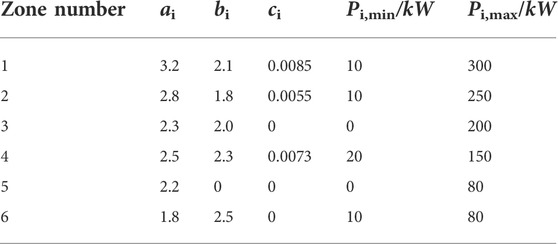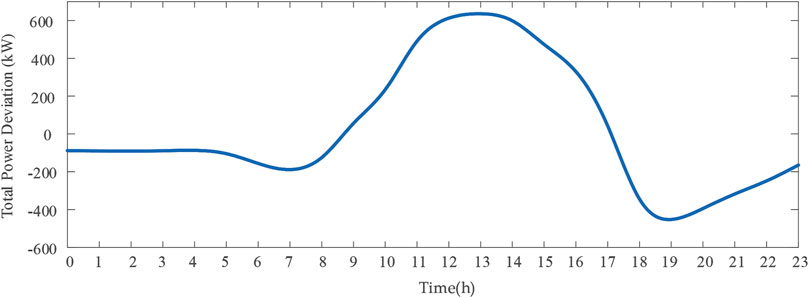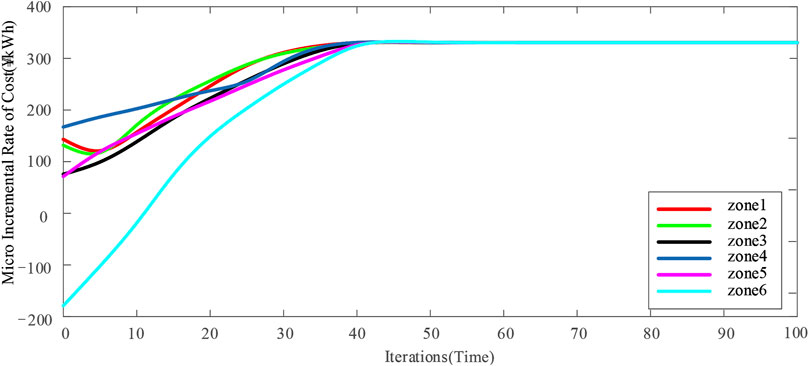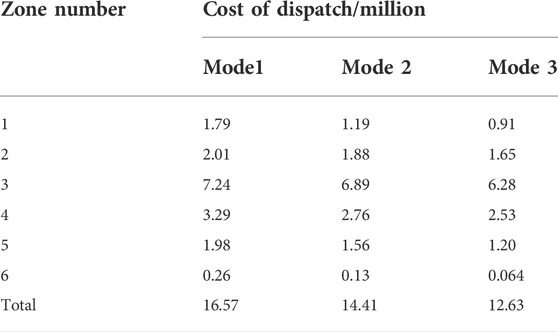- 1Electric Power Research Institute of State Grid Hebei Electric Power Co, Ltd., Shijiazhuang, China
- 2State Grid Hebei Electric Power Co, Ltd., Shijiazhuang, China
- 3Handan Power Supply Branch of State Grid Hebei Electric Power Co, Ltd., Handan, China
- 4Key Lab of Power Electronics for Energy Conservation and Motor Drive of Hebei Province (School of Electrical Engineering, Yanshan University), Qinhuangdao, China
Aiming at the problem of long-timescale prediction deviation in the distribution network, a fast regulation strategy of cloud-edge coordination based on an intelligent transformer supply zones edge consistency algorithm is proposed. The cloud makes the global initial optimal allocation to the edge transformer supply zone clusters, and then the cluster makes the secondary collaborative optimal allocation to the edge zones. A fast power interaction model within a cluster based on a consensus algorithm is established, and the micro-increase rate of dispatching cost is used as the consistency variable so that the cluster adjustment amount is optimally allocated to each transformer supply zone, and the total dispatch cost of all transformer supply zones is minimized. The simulation example verifies the effectiveness of the cloud-edge collaborative fast control strategy based on the intelligent station cluster edge consensus algorithm in this article.
1 Introduction
Under the background of the “double-carbon” goal, China has accelerated the construction of the new electric power system with new energy as the main body. The wide access to a high proportion of distributed new energy and the participation of large-scale resources such as energy storage and flexible load in the regulation and control of the distribution network have affected the safe and stable operation of the system (Peng et al., 2022); how to use the abovementioned resources to coordinate and dispatch is one of the key issues that need to be solved urgently at present (Fang et al., 2019; Zhao et al., 2019).
There have been many studies on the scheduling of using distributed resources. Tofighi-Milani et al. (2022), in order to promote the distributed scheduling of multi-agent systems, proposed a P2P resource management scheme considering network constraints, which can realize that each agent can independently schedule local resources to maximize its own interests. Huang et al. (2022), to manage multiple distributed resources in a microgrid, proposed a two-stage interactive retail electricity market based on interactive energy, which can effectively exploit the flexibility potential of each distributed resource. Huang et al. (2021), in order to promote the free competition of electric energy retailers with multiple distributed resources in the retail market, proposed a transactional retail market mechanism, which reduces the impact of clean energy uncertainty and improves market efficiency. Yang et al. (2021), in order to fully coordinate and utilize flexible resources, proposed a three-timescale coordinated scheduling framework, which can effectively improve the economy of active distribution networks.
With the vigorous development of the Internet of energy (Liu. et al., 2020), he automation and digital transformation of low-voltage distribution transformer supply zone as a unit is gradually carried out in China, and a new generation of intelligent distribution transformer supply zone based on the concept of cloud-edge collaboration and edge computing of the distribution Internet of Things has become one of the construction paths. Cloud-side collaboration can reasonably allocate complex computing tasks. Edge computing implements local data collection and analysis on the side near the data (Gong et al., 2018), and then uploads to the end. The cloud collects the data transmitted from the edges, makes the optimization decision of the whole system, and then sends the control task to each edge. The cloud-edge cooperative dispatching mode fits the distribution characteristics of new energy in the distribution network (Li. and Song, 2021), and is applied to the optimal regulation of the distribution network (Ren et al., 2019), which can effectively solve the problem of a large amount of computing and communication data caused by the access of a high proportion of distributed resources.
There have been some research works on the cloud-edge cooperative dispatching strategy. Peng et al. (2022) proposed the dispatching operation mode of two-level fusion of “cloud brain-edge neuron.” Liu et al. (2020), aiming at the problem of peak regulation in virtual power plants, constructed a multi-energy virtual power plant dispatching technical framework of cloud-edge-end hierarchical cooperation. Si et al. (2020) established the physical architecture of Power Internet of Things based on cloud-edge collaboration, built a CPPS unified computing mathematical model based on edge computing and the idea of cooperative autonomy among clusters and cloud-edge collaborative control, and applied the dispatching calculation of virtual power plants. In order to promote the synergistic interaction between distributed resources and distribution network, Zhou et al. (2022) proposed the Power Internet of Things 5G cloud-edge-end multi-level coordination framework and a cloud-side-end collaborative resource regulation method based on semi-distributed artificial intelligence to achieve collaborative optimization of cloud-side/side-side computing resource allocation. Zhang and Wang (2022) proposed a real-time demand response dispatching strategy of cloud-side collaboration for electric vehicles, and a task unloading strategy of cloud-side collaboration was proposed. A dispatching decision model was established with the goal of minimizing the load difference of the central cloud and maximizing the response benefit of the edge cloud.
Random fluctuation and unpredictability of new energy bring power deviation to distribution network regulation (Bian et al., 2021; Li et al., 2022). Although the cloud-side cooperative regulation strategy can effectively improve the problems of computation and communication, it is difficult to correct the power deviation in time due to the communication delay in the cloud-edge cooperative control. Therefore, it is necessary to seek an efficient and fast dispatch decision-making method (Gong et al., 2018). Compared with remote computing in the cloud, edge computing performs data analysis near the device. Compared with cloud-edge information transmission, it is more convenient and faster to directly exchange data between adjacent edges.
A consensus algorithm is a distributed optimization algorithm to solve the task concentration. It only needs the communication data between local and adjacent units, and completes the iterative optimization between each unit, which can effectively reduce the computation and communication burden. At present, the consensus algorithm has been applied to the coordinated control of the distribution network (Zeraati et al., 2019). Zhang et al. (2020) proposed a distributed energy storage optimization control strategy based on a consensus algorithm for the economic dispatch of autonomous microgrid clusters, and used the consensus algorithm to distribute the output power of energy storage. Pu et al. (2017) proposed a distributed optimization scheduling method based on consistency theory to solve the problem of regional autonomous optimal scheduling in an active distribution network. The incremental cost of distributed power supply was taken as a consistency variable to realize the optimization of power generation cost in the autonomous region. Li et al. (2018), to solve the problem of DC micro-power grid in the centralized control, proposed the multi-objective control strategy based on a consistency algorithm, to realize the voltage stability and power generation cost minimum. Yang et al. (2020) proposed a distributed control strategy based on a consensus algorithm to solve the problem of unbalanced power between photo-voltaic power generation and load in a DC microgrid composed of multiple photovoltaic and battery energy storage units. Taking the control power of batteries as a consistency variable, the unbalanced power can be distributed among batteries according to the real-time state of SoC, avoiding the phenomenon of mutual charging and discharging between batteries. Lv et al. (2019) established a dynamic economic dispatching model of an independent microgrid with energy storage and controllable loads, and proposed a distributed solution algorithm based on a consensus algorithm to realize the optimal power distribution of distributed power and energy storage.
The abovementioned research applies the consensus algorithm to realize the distributed control of the microgrid or adopts the completely distributed scheme to realize the coordinated regulation of the distribution network. However, due to the lack of coordination of centralized links, the distributed scheme is generally only suitable for distributed control with relatively fixed rules, which is difficult to adapt to changes in the power grid environment, and it is difficult to convert complex optimization problems into distributed algorithms. In this article, aiming at correcting the long-term prediction deviation, combined with the characteristics of the cloud and the edge, a real-time dispatch strategy for distribution transformer supply zone cluster based on cloud-edge collaboration architecture is proposed. Multiple zones with adjacent communication functions are formed into a transformer supply zone cluster. The leader of the transformer supply zone cluster sends the power deviation and dispatching cost signals of the cluster to the cloud, and the cloud optimizes the total power deviation of the distribution network to each cluster based on long-term global control. The study aims to minimize the deviation amendment cost; a real-time power interaction model was established based on the consensus algorithm. The micro-increase rate of the cost was taken as the consistency variable of the transformer supply zone cluster, and the consistency iteration was carried out within the cluster, so the power deviation signal of the cluster was optimally allocated to each zone cluster. When cloud-side communication is interrupted, each cluster can independently implement consistent dispatch according to its own power deviation within the cluster, with autonomous ability. The simulation example verifies the effectiveness of the coordinated control strategy of the transformer supply zone cluster based on the consensus algorithm of the edge nodes of the intelligent transformer supply zones.
The main contributions of this article are as follows:
A distributed real-time control scheme of cloud-edge cooperation is proposed, in which the intelligent terminals of the zones are used as the edge computing nodes, and the cloud-edge cooperation is carried out among multiple zones with adjacent communication functions. The cloud allocates the total dispatch amount to the transformer supply zone clusters for the initial allocation. The transformer supply zone cluster then collaboratively distributes the initial dispatching quantity to each transformer zone for secondary allocation. When the communication between the cloud and the edge is interrupted, the transformer supply zone cluster independently performs secondary optimal allocation according to the scheduling amount of the cluster to achieve independent operation.
A centralized-distributed scheduling method based on a consensus algorithm is proposed. The cloud optimally distributes the dispatching volume of the distribution network to the transformer supply zone clusters. With the micro-increase rate of dispatching cost as the consistency variable, the consistency iteration is carried out within the cluster, and the dispatch quantity of the cluster is optimally allocated to each transformer supply zone.
2 Distributed fast power regulation strategy for transformer area clusters under the cloud-edge collaboration architecture
2.1 Cloud-side collaborative power dispatching framework
In the cloud-side collaborative control architecture of a new energy distribution network, the cloud is the control center responsible for the global control of the distribution network system. Its main functions include collecting and processing information transmitted by the edge side, making optimization decisions for the whole system, and issuing control instructions to edge side and assisting edge computing. The edge side is each transformer supply zone, equipped with intelligent distribution transformer terminals, which is mainly responsible for intelligent sensing and aggregation of distributed power, energy storage and controllable load in the transformer supply zones, communication with cloud and adjacent side, executing of edge calculation, load dispatching ability of evaluation and control, etc. The information exchange between the cloud and the side is carried out through the public channel to realize the cloud-edge cooperation; each transformer supply zone is equipped with an independent local controller to exchange information with adjacent stations to realize edge cooperation.
Based on the flexible load, energy storage, and distributed generation resources output, the day-ahead dispatching is carried out with the objective of minimizing the operation cost of the transformer supply zone. According to the forecast of distributed generation resources output and flexible load, to determine the power generation plan of this transformer supply zone cluster, divide 24 h of a day into T periods, assuming that the power of the constituent unit remains basically unchanged in each period. The objective function of the day ahead dispatching is (Huang et al., 2017)
where
In the previous dispatch stage, the cloud performs centralized optimization calculations with the goal of minimizing the cost and optimally allocates the regulation amount to each transformer supply zone cluster because the prediction accuracy decreases with the increase of timescale, and the day ahead scheduling often cannot meet the requirements of power balance. This study takes the optimization value of the long timescale as the reference value to correct the deviation of regulation power from the short timescale. In this study, combined with the characteristics of cloud edge, multiple transformer supply zones with adjacent communication functions are formed into transformer supply zone clusters to form edge nodes, and uses edge computing to adjust and correct the power deviation in real time on a short timescale. Figure 1 shows the real-time dispatch framework for the distribution transformer supply zone cluster based on the cloud-edge collaboration architecture. The “Leader-Follower” distributed dispatching method is adopted within each transformer supply zone cluster (Zhang and Chow, 2011), and the “Leader” of the cluster sends the power deviation and dispatching cost signal of the cluster to the cloud; the cloud summarizes the data information uploaded by all leaders, on a long-term scale; the global centralized dispatch optimization calculation is carried out with the goal of economical optimization, and distributes the optimized power deviation value to the “leaders” of each transformer supply zone cluster for initial distribution; the transformer supply zone clusters then cooperatively allocate the scheduling amount obtained from the initial allocation to each transformer supply zone for secondary allocation. When the communication between cloud and edges is interrupted, the transformer supply zone cluster can optimize the allocation according to the scheduling volume of the cluster to realize independent operation.
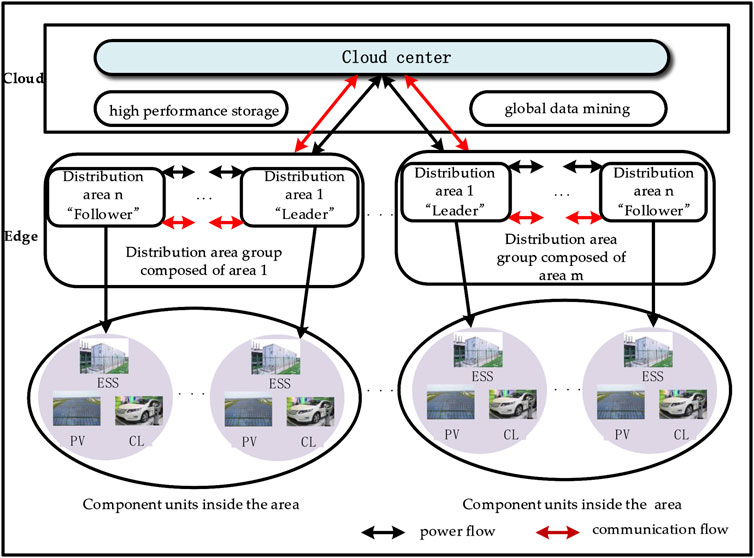
FIGURE 1. Real-time dispatch framework for distribution transformer supply zone cluster based on cloud-edge collaboration architecture.
According to the scheduling results of different stages at the transformer supply zone level, the internal resources of the transformer supply zone are finely controlled, and then the ending resources are optimized and managed according to the target dispatching power of the transformer supply zone. With the best global cost as the goal, the resources in the transformer supply zone are classified and participate in the dispatch in stages. The integrated regulation and control requirements of end transformer supply zones are realized.
The total power deviation of the distribution network is
where
According to the power deviation uploaded by the leader of each transformer supply zone cluster, the cloud performs optimization calculations based on the slight increase rate of equal cost. When the equation shown in Eq. 4 is satisfied, the purpose of optimizing power deviation distribution to each power transformer supply zone cluster can be achieved with the goal of economy.
where
When the micro-increase rate of cost of all transformer supply zone clusters is consistent, the optimal power deviation value to be corrected for each cluster under the lowest dispatch cost is obtained; that is, it meets the relationship shown in Eq. 5.
where
2.2 Distribution zone cluster members and functions
There are multiple transformer supply zones in the transformer supply zone cluster, and each transformer supply zone has the resources that can participate in the dispatch. Considering that the type and quantity of distributed power supply, energy storage, and flexible load may be different in each transformer supply zone, for the convenience of expression, the units inside the zone are no longer distinguished here; each transformer supply zone is regarded as an edge node, and in order to ensure that the distribution transformer supply zones cluster has high communication reliability (Zhang and Chow, 2012), the transformer supply zone with good communication and computing capabilities is selected as the “Leader,” and the rest of the transformer supply zones are selected as “followers.”
Leader: As the most important transformer supply zone in the transformer supply zone cluster, it is required to have high communication reliability and good computing capability. It can interact with the cloud for data and information, upload the power deviation of the local transformer supply zone cluster to the cloud, and receive the optimized power deviation value from the cloud; it can carry out communication exchange with adjacent transformer supply zones, obtain the information transmitted by adjacent transformer supply zones, and update the dispatching information of transformer supply zone in the cluster based on the consensus algorithm.
Follower: All transformer supply zones except “Leader”; they do not need to communicate with the cloud, only interact with adjacent transformer supply zones, and update the dispatching information of the transformer supply zone based on the consensus algorithm.
3 Consistent distributed control method for transformer area cluster
3.1 Consistency theory
3.1.1 Distributed topological graph theory
In this article, optimization is carried out with the goal of minimizing the dispatch cost of all transformer supply zones. It is necessary to coordinate control among multiple zones so that the cost micro-increase rate in the multi-distribution transformer supply zones system tends to a stable common value, which belongs to the consistency of the transformer supply zones.
In the problem of real-time dispatching consistency in transformer supply zones cluster, information is interacted through the communication network between the transformer supply zones, forming a distributed topology, so that can be described by graph theory. The communication relationship between the transformer supply zones of a transformer supply zone cluster can be represented by a directed graph
Define the matrix
3.1.2 Consensus algorithm
In order to effectively reduce the computational and communication burden of cloud-side coordinated control of distribution networks, a centralized-distributed dispatch method based on a consensus algorithm is proposed in this article. In the day-ahead stage, the centralized optimization calculation is performed by the cloud, and in the real-time stage, the coordinated regulation of each transformer supply zone is transformed into a distributed control in the distribution transformer supply zones cluster. The consistency algorithm exchanges information between the local controller and adjacent controllers, and performs iterative calculations in each controller to make the selected consistency variables tend to a common value (Zheng et al., 2022). The calculation process is distributed computing. Therefore, each distribution transformer supply zone can be linked by the consensus algorithm so as to realize the coordinated regulation of the distribution transformer supply zones cluster. The proposed centralized-distributed dispatch method based on the consensus algorithm can not only solve the problem of high computational pressure of the centralized control method but also overcome the global limitation of the distributed control method so that the proposed method combines the advantages of both and overcome the shortcomings of both.
Considering the transformer supply zone as a node, for node
where
where
3.2 Consistent and distributed control model for transformer supply zone
3.2.1 Dispatching cost function of zone
For the transformer supply zone, the internal resource attributes are no longer distinguished. The dispatching target is to minimize the dispatching cost of each transformer supply zone in the transformer supply zone cluster, which can be expressed as
where
The flexible resources involved in the real-time dispatch of the transformer supply zone mainly include distributed generation resources, flexible load, and energy storage. Among them, the power dispatch cost function of distributed generation resources can be expressed as (Rahbari-Asr et al., 2014)
where
The operating cost function of the energy storage device is expressed as (Rahbari-Asr et al., 2014)
where
The cost function of flexible load is usually expressed by quadratic function (Liu et al., 2021):
where
According to Eqs 10–12, the dispatching cost function of the
where
The abovementioned calculation method is suitable for the case where the number of distributed resources in the transformer supply zone is small. When the number of distributed resources in the transformer supply zone is large, the K-means algorithm is used to cluster resources with the same response characteristics, which can significantly reduce the amount of calculation.
The power balance constraint of the distribution network is expressed as
where
The upper and lower limit constraints of distribution network dispatch power are expressed as
where
3.2.2 Consistent power dispatching method
According to the principle of the equal cost increment rate, when the adjustment cost increment rate of all stations tends to be the same, the total control cost of the station group can be minimized, and the optimal distribution of the station area control power can be achieved.
According to the equal micro-increase rate of cost, when the micro-increase rate of dispatching cost in all zones tends to be the same, the total control cost of the transformer supply zone cluster can be minimized, and the optimal distribution of the transformer supply zones cluster dispatch power can be achieved. Based on the abovementioned analysis, this article selects the micro-increase rate of cost of each transformer supply zone as the consistency variable, and uses the consistency algorithm to continuously update the consistency variable and update the dispatching power of the transformer supply zone at the same time. When the consistency variables of each transformer supply zone tend to be consistent, the optimal distribution of dispatching power in each transformer supply zone will be realized.
It can be obtained from Eq. 17:
The slight increase rate of control cost of station
where
According to the micro-increase rate of dispatching cost at
where
In the iterative calculation process of the consensus algorithm,
Iteratively updating
3.3 Proof of convergence of consistency algorithm
The proof of the convergence of the consensus algorithm with the micro-increase rate of cost as the consensus variable is shown below.
After repeated iterative calculation using the consistency algorithm, the micro-increase rate of cost of each transformer supply zone can be achieved:
where
The transformer area dispatching cost function
A Lyapunov multivariate function about the dispatching power of each transformer supply zone is defined V; its definition domain is the vector composed of the limit value of dispatch power in each transformer supply zone, and V can be expressed as
where
Assuming that in the kth iteration calculation all transformer supply zones reach the state shown in Eq. 25, the following relationship exists:
That is,
The solution process of real-time dispatch of transformer supply zone cluster
Flowchart of the power dispatch strategy in edge-side cooperative transformer supply zone based on the consensus algorithm is shown in Figure 2. The specific steps are as follows:
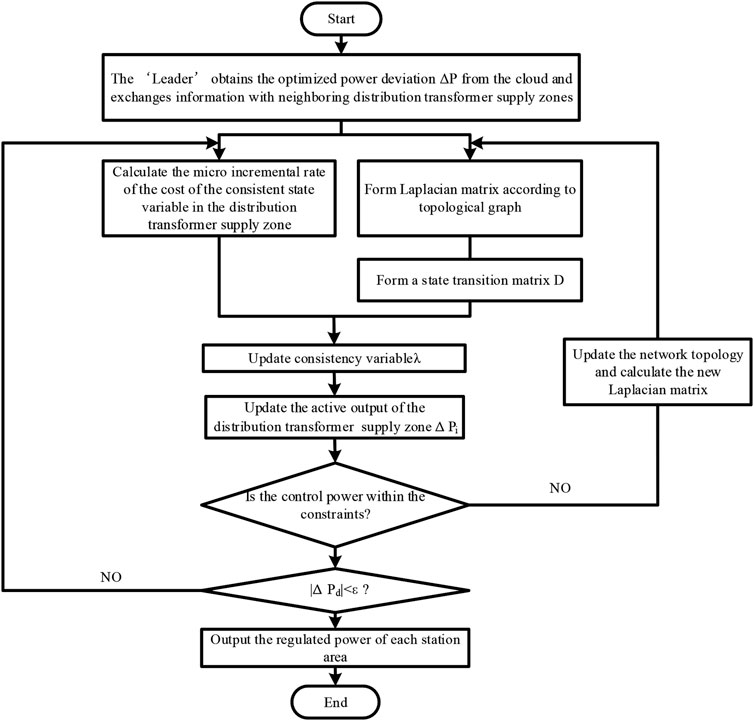
FIGURE 2. Flowchart of the power dispatch strategy in edge-side cooperative distribution transformer supply zone based on the consensus algorithm.
Step 1: The “Leader” transformer supply zone obtains the power deviation allocated after cloud optimization calculation and carries out information interaction with adjacent zones to calculate the consistent state variable value of each transformer supply zone;
Step 2: Obtain Laplace matrix
Step 3: Update the consistency variable of each transformer supply zone cluster according to Eq. 18 and obtain the dispatched power of the transformer supply zone in this state according to Eq. 20;
Step 4: Judge whether the updated dispatch power value meets the constraint conditions. If not, update the network topology again, find the state transition matrix again, and repeat Step 3.
Step 5: Determine whether
4 Example analysis
4.1 Illustration of the calculation
To verify the effectiveness of the strategy proposed in this article, a typical active distribution network demonstration project in a city is used as an example for calculation and analysis. The network topology of the transformer supply zone cluster is shown in Figure 3. The transformer supply zone cluster consists of six zones, with zone 1 as the “Leader” and zone 2 to zone 6 as the “Followers.” The voltage level of each transformer zone is 10 kV/380 V and the frequency is 50 Hz in the model of the transformer supply zone cluster built in this article.
The categories of constituent units contained in each transformer supply zone cluster are shown in Table 1; zone 1 contains distributed generation resources, energy storage devices, and flexible loads; zone 2 contains distributed generation resources and flexible loads; zone 3 contains energy storage devices and flexible loads; zone 4 contains only distributed generation resources; zone 5 contains only energy storage devices; zone 6 contains only flexible loads.
We have to synthesize the control resources in the transformer supply zone, and perform linear convex combination to obtain the total cost parameters of the transformer supply zone. The parameters for each transformer supply zone are set as shown in Table 2, which contains the cost coefficient for each transformer supply zone and the upper and lower active output limits.
4.2 Analysis of example results
The real-time power dispatch simulation analysis of the transformer supply zone cluster is carried out with a dispatch period of 15 min, and the total duration is 24 h; then a total of 96 dispatch plans are included. The power dispatching coefficient of the consistency algorithm
The whole-day total power deviation curve is obtained from the predicted value and the actual value of the previous power regulation, as shown in Figure 4, which shows that the power imbalance mainly occurs between 11:00–22:00. The maximum positive power deviation occurs at 14:00, and the power deviation value is 630 kW. The main reason is that due to the large photovoltaic output at noon, there is excess electric energy. At this time, the generated power shall be reduced, energy storage should be charged, and the load should be increased; the maximum negative power deviation occurs at 18:00 with a power deviation value of −450 kW, which is mainly due to the power shortage caused by the peak load in the evening; at this time, we should increase the power generation, discharge energy, and cut the load.
Based on the analysis of historical data in the region, the controllable active power prediction value of the transformer supply zone on a long-term scale of a typical day in the zone obtained from the distribution network management center is shown in Figure 5.
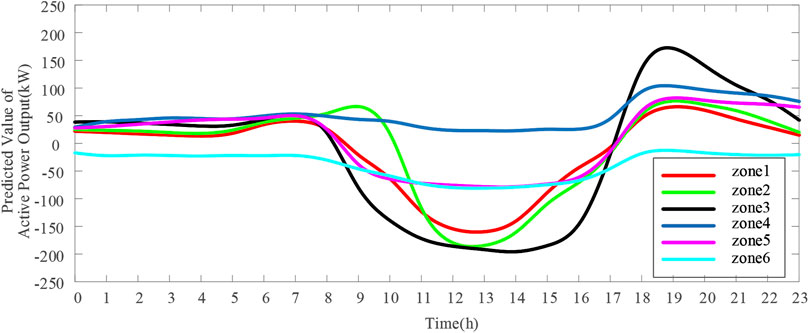
FIGURE 5. Adjustable active power prediction value of each distribution transformer supply zone on a long timescale.
Applying a cloud-edge collaborative real-time control strategy based on the edge consistency algorithm of the intelligent transformer supply zone cluster to this power transformer supply zones, the simulation results can be obtained as shown in Figures 6, 7.
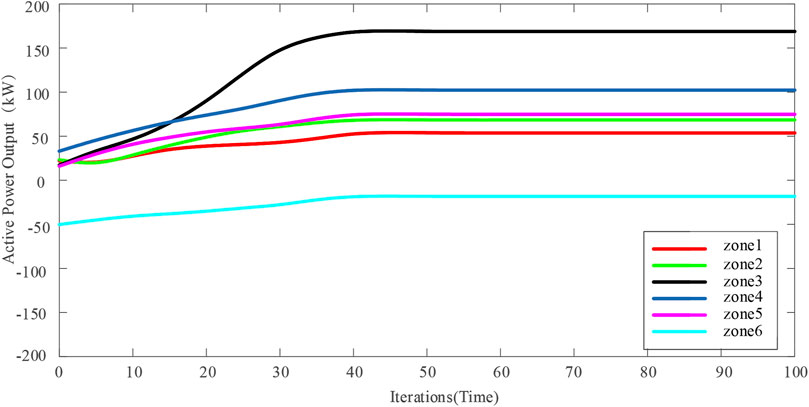
FIGURE 7. Iterative process of the active power output of each distribution transformer supply zone at 18:00.
It can be seen from Figure 6 that the initial value of the micro-increase rate of cost of each transformer zone is different. The value of the micro-increase rate of cost of zone 3 is the highest, the value of the micro-increase rate of cost of zone 6 is the lowest, and its growth rate is the fastest. After the consensus algorithm of the iterative update calculation, the micro-increase rate of cost for zone 1 and zone 2 gradually increases after the first decrease, and the cost incremental rate for zone 3 to zone 6 gradually increases, and when the number of iterations reaches 40, the value of cost incremental rate in all zones tends to be the same, which is 330.57 ¥/kWh.
As can be seen from Figure 7, after the iterative update calculation of the consensus algorithm, in the initial stage, the active power output of zone 1 and zone 2 first decreases and then gradually increases; the active power output of zone3 to zone 6 gradually increases. At the 40th iteration, the active power output of all zones stabilizes. The active power output from transformer supply zone 1 to transformer supply zone 6 tends to be stable, respectively: P1 = 53.75 kW, P2 = 68.45 kW, P3 = 168.85 kW, P4 = 102.31 kW, P5 = 74.89 kW, and P6 = -18.25 kW, which shows that the active power outputs values of all transformer supply zones are within the operational constraints.
4.3 Comparative analysis of different control methods
In order to verify the effectiveness and economy of the dispatching strategy proposed in this article, the following three control methods are used for the transformer supply zone cluster for comparative analysis.
Mode 1: No information interaction between transformer supply zones; each transformer supply zone operates independently.
Mode 2: Information interaction between transformer supply zones, with each transformer supply zone giving priority to autonomy and taking the initiative to exchange power with the cluster to maintain the cluster’s power balance when its own power command differs from the power command of the transformer supply zone cluster.
Mode 3: Information interaction between each transformer supply zone is controlled according to the cloud-edge collaborative fast control strategy based on the intelligent transformer supply zone edge consensus algorithm proposed in this article.
Simulation and analysis of these three control methods were carried out separately, and the total dispatching cost of the transformer supply zone cluster and the dispatching cost of each transformer zone are shown in Table 3.
Table 3 shows that with Mode 3 control, the dispatching cost of each transformer zone is less than those of Mode 1 and Mode 2 control. The total dispatching cost is “Mode 1 > Mode 2 > Mode 3,” and the total dispatching cost of Mode 3 is 23.8% lower than that of Mode 1 and 12.35% lower than that of Mode 2, indicating that the proposed strategy can achieve the optimal economic dispatch of the active output.
In Mode 1, each zone operates independently, and when power deviation occurs, it can only rely on its own internal regulation to make power balance, which will result in more abandoned generation and load shedding; in Mode 2, each transformer zone gives priority to self-governance, and when self-governance still cannot make system power balance, then it relies on information interaction with neighboring zones for dispatching; Mode 3 adopts the cloud-edge coordination real-time control strategy based on the intelligent transformer supply zone cluster edge consensus algorithm proposed in this study to control, and for each transformer zone, the active power is allocated based on the micro-increase rate of cost, which can achieve real-time and economic power dispatch.
4.4 Experimental results
In this experiment, RT-Lab is used to physically model the distribution network transformer supply zone cluster in the example, and the semi-physical simulation of the real-time dispatching of the distribution transformer supply zone cluster with cloud-edge coordination is carried out. According to the distribution network structure in the calculation example, a cloud center computing data pool and 6 edge computing groups quantitatively analyze the transmission delay advantage of the centralized-distributed control method in the scheduling process, so as to illustrate the establishment and use of the model in this article , and to verify the rationality and versatility of the model. Table 4 shows the computing delays on the cloud and edge sides. Table 5 shows the comparison of model effects of different control methods.
It can be seen from Table 5 that the computing speed of the centralized-distributed cooperative control method based on cloud-side collaboration is not much different from that of the distributed control method. Compared with the traditional centralized control method, it has a lower communication time. The calculation speed is significantly faster than that of the centralized control method.
5 Conclusion
In order to correct the long-timescale prediction bias in the distribution network, this article proposes a fast cloud-side coordinated dispatching strategy based on the edge consistency algorithm of intelligent transformer areas cluster, in which the cloud makes the first global optimal allocation and the transformer area makes the second coordinated optimal allocation on the edge side. Based on the consensus algorithm, each area uses the micro-increase rate of dispatching cost as a consistent variable and performs consistent iterations to achieve the optimal distribution of the dispatching power in the transformer area. The main advantages of this article are as follows:
1) The burden of the cloud is reduced. The cloud is responsible for optimizing the calculation of the cluster power deviation information uploaded by the leaders of each cluster and the dispatching cost, which reduces the calculation amount. The iterative calculation is distributed in each edge transformer area, which reduces the communication delay and ensures the rapid power dispatch of the transformer areas cluster.
2) Only the adjacent distribution station areas in the cluster exchange information, which reduces the communication burden of the communication network and improves the reliability of communication.
3) The cost micro-increase rate is selected as the consistency variable. When the cost micro-increase rate tends to be consistent, it can ensure that the power distribution transformer supply zone cluster can perform power regulation at a lower cost.
There are still some deficiencies in the work done in this article. This article only considers the cooperative power interaction between the distribution stations and does not consider the information interaction between groups. This problem will continue to be studied in the next work.
Data availability statement
The raw data supporting the conclusions of this article will be made available by the authors, without undue reservation.
Author contributions
JIL and JUL contributed to framework establishment and manuscript writing; PL and HF contributed to provide theoretical support; SZ and GY contributed to model solving.
Funding
The work has been supported by the Science and Technology Program of Hebei Province (20314301D).
Conflict of interest
Authors PL and JL were employed by the company Electric Power Research Institute of State Grid Hebei Electric Power Co, Ltd. Author HF was employed by the company State Grid Hebei Electric Power Co, Ltd. Author GY was employed by the company Handan Power Supply Branch of State Grid Hebei Electric Power Co, Ltd.
The remaining author declares that the research was conducted in the absence of any commercial or financial relationships that could be construed as a potential conflict of interest.
Publisher’s note
All claims expressed in this article are solely those of the authors and do not necessarily represent those of their affiliated organizations, or those of the publisher, the editors, and the reviewers. Any product that may be evaluated in this article, or claim that may be made by its manufacturer, is not guaranteed or endorsed by the publisher.
References
Bian, X., Sun, M., Zhao, J., Lin, S., Zhou, B., and Li, D. (2021). Distributed coordinative optimal dispatch and control of source and load based on consensus algorithm. Proc. CSEE 41 (04), 1334–1347+1540. doi:10.13334/j.0258-8013.pcsee.200416
Fang, X., Hodge, B.-M., Jiang, H., and Zhang, Y. (2019). Decentralized wind uncertainty management: Alternating direction method of multipliers based distributionally-robust chance constrained optimal power flow. Appl. Energy 239, 938–947. doi:10.1016/j.apenergy.2019.01.259
Gong, G., Luo, A., Chen, Z., Luan, J., An, X., and Wang, X. (2018). Cyber physical system of active distribution network based on edge computing. Power Syst. Technol. 42 (10), 3128–3135. doi:10.13335/j.1000-3673.pst.2018.0119
Huang, C., Wang, C., Zhang, M., Xie, N., and Wang, Y. (2021). A transactive retail market mechanism for active distribution network integrated with large-scale distributed energy resources. IEEE Trans. Smart Grid 12 (5), 4225–4237. doi:10.1109/TSG.2021.3087720
Huang, C., Zhang, M., Wang, C., Xie, N., and Yuan, Z. (2022). An interactive two-stage retail electricity market for microgrids with peer-to-peer flexibility trading. Appl. Energy 315, 119085. doi:10.1016/j.apenergy.2022.119085
Huang, W., Li, N., Tian, Y., and Zhang, Z. (2017). Research on day-ahead and real-time schedule strategy for ADN. Mod. Electr. 34 (03), 52–59. doi:10.19725/j.cnki.1007-2322.2017.03.008
Li, X., Han, X., and Yang, M. (2022). Day-ahead optimal dispatch strategy for active distribution network based on improved deep reinforcement learning. IEEE Access 10, 9357–9370. doi:10.1109/ACCESS.2022.3141824
Li, Y., Dong, P., Liu, M., and Lin, Y. (2018). Distributed coordinated control of DC microgrid based on finite-time consensus algorithm. Automation Electr. Power Syst. 42 (16), 96–103. doi:10.7500/AEPS20170907003
Li, Z., Song, K., Ding, M., Ni, R., Wang, J., Qu, L., et al. (2021). Comparative analysis of three data mining techniques in diagnosis of lung cancer. Eur. J. Cancer Prev. 40 (06), 15–20. doi:10.1097/CEJ.0000000000000598
Liu, H., Li, Z., Cheng, Q., Yao, T., Yang, X., and Hu, Y. (2020). Construction of the evaluation index system of the regional integrated energy system compatible with the hierarchical structure of the energy Internet.” in. IEEE 4th Conference on Energy Internet and Energy System Integration (EI2), Wuhan, China, October 30–November 1, 2020, 342–348. doi:10.1109/EI250167.2020.9346665
Liu, T., Han, D., Wang, Y., and Dong, X. (2021). Strategies of market game behavior of virtual power plants based on Q-learning with augmented Lagrange function. Power Syst. Technol. 45 (10), 4000–4008. doi:10.13335/j.1000-3673.pst.2020.1932
Lv, P., Zhao, J., Su, D., and Chen, G. (2019). Consensus-based distributed dynamic economic dispatching for islanged microgrids. Automation Electr. Power Syst. 43 (05), 22–29. doi:10.7500/AEPS20180214001
Peng, C., Liu, Y., Zhou, H., Liu, F., Zhang, K., and Hu, R. (2022). Power ecosystem operation based on cloud-edge collaboration: Theoretical framework. Proc. CSEE 42 (09), 3204–3214. doi:10.13334/j.0258-8013.pcsee.202422
Pu, T., Liu, W., Chen, N., Wang, X., and Dong, L. (2017). Distributed optimal dispatching of active distribution network based on consensus algorithm. Proc. CSEE 37 (06), 1579–1590. doi:10.13334/j.0258-8013.pcsee.160937
Rahbari-Asr, N., Ojha, U., Zhang, Z., and Chow, M. (2014). Incremental welfare consensus algorithm for cooperative distributed generation/demand response in Smart grid. IEEE Trans. Smart Grid 5 (6), 2836–2845. doi:10.1109/TSG.2014.2346511
Ren, J., Yu, G., He, Y., and Li, G. Y. (2019). Collaborative cloud and edge computing for latency minimization. IEEE Trans. Veh. Technol. 68 (5), 5031–5044. doi:10.1109/TVT.2019.2904244
Si, Y., Tan, Y., Wang, F., Kang, W., and Liu, S. (2020). Cloud-edge collaborative structure model for power Internet of Things. Proc. CSEE 40 (24), 7973–7979+8234. doi:10.13334/j.0258-8013.pcsee.191532
Tofighi-Milani, M., Fattaheian-Dehkordi, S., Fotuhi-Firuzabad, M., and Lehtonen, M. (2022). Decentralized active power management in multi-agent distribution systems considering congestion issue. IEEE Trans. Smart Grid 13, 3582–3593. doi:10.1109/TSG.2022.3172757
Yang, Q., Huang, Y., Shi, M., Zhou, J., Chen, X., and Wen, J. (2020). Consensus based distributed control for multiple PV-battery storage units in DC microgrid. Proc. CSEE 40 (12), 3919–3928. doi:10.13334/j.0258-8013.pcsee.190444
Yang, X., Xu, C., Zhang, Y., Yao, W., Wen, J., and Cheng, S. (2021). Real-time coordinated scheduling for ADNs with soft open points and charging stations. IEEE Trans. Power Syst. 36 (6), 5486–5499. doi:10.1109/TPWRS.2021.3070036
Zeraati, M., Hamedani Golshan, M. E., and Guerrero, J. M. (2019). A consensus-based cooperative control of PEV battery and PV active power curtailment for voltage regulation in distribution networks. IEEE Trans. Smart Grid 10 (1), 670–680. doi:10.1109/TSG.2017.2749623
Zhang, B., Wang, J., Liang, D., and Han, X. (2020). Optimization control strategy of distributed energy storage in autonomous microgrid cluster on consensus algorithm. Power Syst. Technol. 44 (05), 1705–1713. doi:10.13335/j.1000-3673.pst.2019.1968
Zhang, W., and Wang, D. (2022). Real-time demand response scheduling strategy for electric vehicles based on cloud edge collaboration. Power Syst. Technol. 46 (04), 1447–1458. doi:10.13335/j.1000-3673.pst.2021.0581
Zhang, Z., and Chow, M.-Y. (2012). Convergence analysis of the incremental cost consensus algorithm under different communication network topologies in a Smart grid. IEEE Trans. Power Syst. 27 (4), 1761–1768. doi:10.1109/TPWRS.2012.2188912
Zhang, Z., and Chow, M.-Y. (2011). “The leader election criterion for decentralized economic dispatch using incremental cost consensus algorithm,” in IECON 2011-37th annual conference of the IEEE industrial electronics society (Raleigh: IEEE), 2730–2735. doi:10.1109/IECON.2011.6119743
Zhao, Y., Wu, Z., Qian, Z., Gu, W., Li, D., and Liu, Y. (2019). Distributed optimal dispatch of active distribution network considering source-load temporal and spatial correlations. Automation Electr. Power Syst. 43 (19), 68–76. doi:10.7500/AEPS20190423003
Zheng, J., Wang, J., Sun, Z., and Wu, F. (2022). Improved droop control of optical storage DC microgrid based on consensus algorithm. Proc. CSUEPSA 34 (04), 116–125. doi:10.19635/j.cnki.csu-epsa.000859
Keywords: transformer supply zone, coordinate the edge sides, power deviation, distributed dispatch, consensus algorithm
Citation: Luo P, Liang J, Fan H, Zeng S, Yang G and Lin J (2022) Real-time distributed dispatch strategy for distribution transformer supply zone cluster based on cloud-edge collaboration architecture. Front. Energy Res. 10:1019349. doi: 10.3389/fenrg.2022.1019349
Received: 15 August 2022; Accepted: 22 August 2022;
Published: 20 September 2022.
Edited by:
Nantian Huang, Northeast Electric Power University, ChinaReviewed by:
Wenxia Liu, North China Electric Power University, ChinaChengmin Wang, Shanghai Jiao Tong University, China
Copyright © 2022 Luo, Liang, Fan, Zeng, Yang and Lin. This is an open-access article distributed under the terms of the Creative Commons Attribution License (CC BY). The use, distribution or reproduction in other forums is permitted, provided the original author(s) and the copyright owner(s) are credited and that the original publication in this journal is cited, in accordance with accepted academic practice. No use, distribution or reproduction is permitted which does not comply with these terms.
*Correspondence: Jifeng Liang, bGppZmVuZ0AxMjYuY29t; Junming Lin, bGptMTIxNjE4MjMzNDYyMzE5QDEyNi5jb20=
 Peng Luo1
Peng Luo1 Junming Lin
Junming Lin

